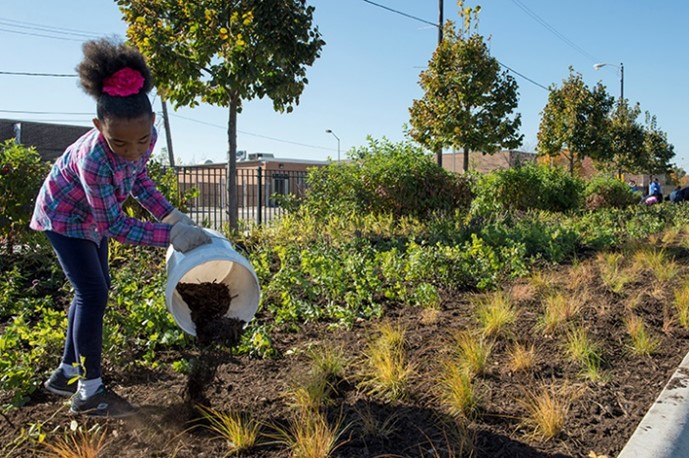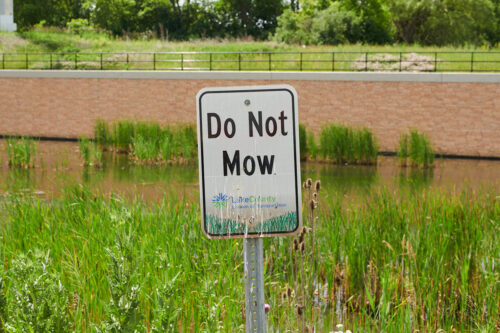Overview

Space to Grow is a partnership of Chicago Public Schools, Metropolitan Water Reclamation District, Openlands, Department of Water Management, and Healthy Schools.
Implementing a successful GSI program takes time, and addressing concerns and barriers during the process is critical. Considerations include: final design specification; project costing, financing, and funding; construction; and short- and long-term maintenance.
For planted GSI, such as rain gardens and bioswales, plant selection plays a key role in its long-term success.
Outcomes
Green stormwater infrastructure project implementation results in in-the-ground systems that improve stormwater runoff management by capturing rain where it falls. The direct benefits of implementing GSI projects include reduced flooding and improved water quality. In addition, implementing GSI projects provides numerous co-benefits, contributing to ecosystem services such as biodiversity, reduced heat island effects, and positive health outcomes through improved recreational opportunities.
Recommended Involvement
Below are broad recommendations for who might be involved in implementation of GSI. As always, evaluate participation in accordance with your specific project.
Community engagement can be used to support ongoing success of GSI projects. Engaging community members from the design process to implementation can further tailor the needs and priorities of local residents into installations. Activities can include:
- Providing education on GSI benefits and training opportunities.
- Establishing funding partnerships to ensure that GSI projects receive the necessary resources to be successful.
- Addressing ongoing training and maintenance needs to ensure project success after installation.
- Engaging community members in selecting plants for GSI installations to ensure they meet local preferences and to build a sense of stewardship
- Creating a conduit between the community and university extension and academia to collaborate on funding proposals and address demonstration project needs.
To learn more see the Engagement step of the design process.
Green stormwater infrastructure implementation requires a wide variety of expertise and collaboration across these areas of expertise. In addition to primary areas of expertise mentioned in the GSI Design section—landscape architecture, urban planning, the community—expertise that is particularly important to GSI implementation includes civil engineering, construction management, moving of transportation and materials, landscaping and restoration, water/wastewater/stormwater management, and more.
Civil engineers both design and construct GSI systems. Construction managers ensure installations meet design specifications, timelines, and estimated costs; including coordinating transportation and materials moving required for construction. Landscaping and ecological restoration professionals are important to the planting and maintenance plans for planted GSI. Water/wastewater/stormwater professionals can assist with the operation and maintenance of GSI systems, including monitoring, inspection, and repair.
Once installed, long-term maintenance expertise is necessary. This responsibility needs to be clearly assigned for successful GSI performance. Unless otherwise assigned, the property owner is typically responsible for maintaining the GSI that is installed on their property. Property owners may consult maintenance professionals or seek maintenance training.
To learn more about professionals and their roles in GSI Design, see Who Might be Involved in GSI Design?
Local government and municipal personnel are critical to the implementation and construction of GSI, as they:
- Develop GSI policies and regulations, and incentives.
- Work closely with community members and other GSI professionals to ensure projects meet local needs.
- Issue GSI construction permits and approvals and ensure projects comply with local regulations.
- May contribute to project funding and financing.
- Help oversee construction, inspection, monitoring, and maintenance.
- Integrate GSI planning into other local and regional planning processes.
- Coordinate local GSI implementation with neighboring communities and regional efforts.
- Integrate projects into a GSI inventory.
To learn more about the stormwater management authority of local government, see Illinois regulations.
Tasks
- GSI designers support the final design preparation, specifications, construction plans, and planting and maintenance plans. This involves the collaboration of municipal and consulting engineers to: ensure the design meets local regulations; prepare final cost estimates; and explore traditional and innovative GSI funding and financing sources and address funding barriers.
- The team reviews and revises local policies, codes, ordinances, regulations, and standards to address any GSI barriers and ensure implementation consistency across projects. This involves working with local governments, regulatory agencies, legal counsel, and others.
- The team continues to refine the GSI objectives and performance metrics in consultation with the community, incorporating feedback.
Designers and engineers work closely with GSI construction consultants and personnel as they:
- Prepare the construction site, including removing any existing structures, grading the site to create the proper slope for drainage, excavating the site, and preparing the soil to ensure proper drainage.
- Construct the GSI, including installing it according to the design specifications. This may involve installing permeable pavement, rain garden underdrainage systems, and other GSI components.
This process ensures proper execution and installation of the GSI design.
Planting and vegetation management are important components of GSI projects, and involve:
1. Understanding site growing conditions to ensure that the selected plants are well suited to the site. This may involve assessing factors such as sunlight and shade, soil type and quality, moisture levels, and climate.
2. Creating a planting plan, including selecting native plants. Once the plan has been developed, the plants can be installed in the GSI according to design specifications.
3. Considering maintenance and stewardship, including regular watering and fertilization, pruning and trimming of plants, weed control, and engagement of local stakeholders and community members in GSI stewardship.
The maintenance, monitoring, and ongoing outreach of GSI implementation involves several key activities, including:
- Maintenance: GSI requires ongoing maintenance to ensure that it maintains its functionality over time. Maintenance activities may include cleaning out catch basins, removing sediment from rain gardens, trimming vegetation, and ensuring that stormwater is flowing properly through the system. It is also important to create programs, policies, and funding to address GSI maintenance throughout the project life cycle.
- Monitoring: Regular monitoring is important to assess GSI effectiveness and identify areas where improvements may be needed. Monitoring may involve assessing the growth and health of vegetation and tracking the volume and quality of stormwater runoff.
- Outreach: Engagement and outreach can help build community support for GSI projects. This may involve educating about GSI benefits, engaging community members and conducting educational workshops and training sessions, and involving community members in long-term maintenance.
- Adaptive management: Allow for adaptive management approaches to community stormwater visioning, standards development, and planning because community knowledge, capacity, partners, technical knowledge, and preferences change over time. This approach recognizes the complexity of GSI, and the need to make adjustments over time based on ongoing monitoring and evaluation.
Resources
Plant Finder – Use this tool to find plans suitable to your site conditions
Final Design and Specification
- Illinois Urban Manual
- MWRD Watershed Management Ordinance
- MWRD Technical Guidance Manual
- A Design Guide for Green Stormwater Infrastructure Best Management Practices
- State of Illinois Illinois Department of Natural Resources Model Stormwater Management Ordinance
- Minnesota Stormwater Manual CADD Images for Individual Best Management Practices
- Policy: An Audit of Municipal Codes and Ordinances to Tackle Barriers to Green Infrastructure
Costing, Financing, and Funding
- Green Infrastructure Municipal Resources and Funding Opportunities
- Community-Enabled Lifecycle Analysis of Stormwater Infrastructure Costs
- A Guide to Assessing Green Infrastructure Costs and Benefits for Flood Reduction
- Getting to Green: Paying for Green Infrastructure Financing Options and Resources for Local Decision-Makers
- Increasing Funding and Financing Options for Sustainable Stormwater Management
- StormStore – a stormwater credit marketplace for entities in Cook County
Maintenance, Monitoring, and Ongoing Outreach
- Green City, Clean Waters Green Infrastructure Maintenance Manual
- Elements of a Green Infrastructure Maintenance Business Plan
- National Green Infrastructure Certification Program Body of Knowledge
- MWRD Checklists Porous Pavement and Bioswales (see resources folder)
- Green Infrastructure Maintenance Video Series

